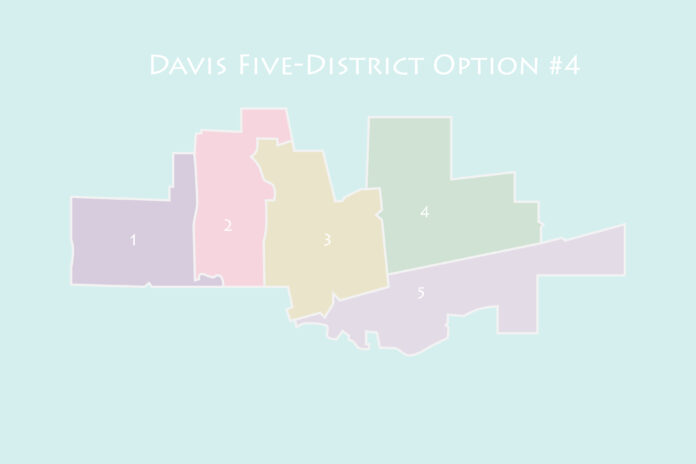New district map approved after lengthy planning, community input period
After months of meetings, public outreach and planning, the city council selected a new map of the city on Oct. 22 that will divide Davis into five separate voting districts, each with its own representative council member.
The new district map was the fourth version of a five-district model, one among ten potential districts maps released in two sets on Oct. 1 and Oct. 15. Four of the maps divided the city into five districts and six of them into seven districts. The final map approved by the council can be found on the city website, along with additional demographic data for each new district.
The Oct. 22 council meeting marked the fourth and final public hearing on the district mapping process, according to the city’s website. Much of the debate during the meeting centered around whether the city should be divided into five or seven districts.
After a short presentation on each of the potential district maps, the council opened up the floor to public comment. The discussion drew an unusually high number of community members, with over 20 different individuals delivering input in two-minute comments.
Many commenters advocated for five districts, citing a desire to keep council procedures simple. Supporters of the five-district maps expressed a desire to make the number of council members low and the city meetings shorter. Some also argued that Davis’ relatively small size did not warrant more than five districts.
Greg Rowe, a member of the Davis Planning Commission, compared the population of Davis to larger cities where he had worked, like Cincinnati, which has nine districts or Oakland, with seven districts.
“Davis is not that large of a town — it’s 68,000 people,” Rowe said. “I just don’t see the need to have the same number of districts that you see in cities that are substantially larger.”
Many students who attended the meeting spoke in favor of a seven-district map, arguing that one or more districts with a majority of renters would better represent student populations during elections.
Brooke Pritchard, president of the Davis College Democrats, argued that a majority-student district would give UC Davis students a voice in important city matters relevant to their concerns, including tenant rights and cost-of-living issues.
“Because 55% of students are Davis residents, without a district aimed towards Davis students, we will inevitably be disenfranchised,” Pritchard said.
Council members, on their part, also initially disagreed over whether five or seven districts would best serve the needs of the city.
Councilmembers Dan Carson and Will Arnold, as well as Mayor Pro Tempore Gloria Partida, supported a five-district map. Carson argued that a seven-person city council makes it more difficult for the council to address city-wide issues in a unified manner.
“There are really important issues coming to our city: on finances, on land use, on housing,” Carson said. ”We need, more than ever, to work closely and cohesively together and I think a five-district map gives us the best chance of doing that.”
Partida, though voicing her support for a five-district map, expressed displeasure with the districting process itself, saying that she believed it ultimately disenfranchised the Latinx population in Davis.
“What this has done for the Latino population is that we’re at [around] 11% in these districts, so this process has actually disenfranchised the Latino population,” Partida said. “The highest that I think I’ve seen is at 17%, so that’s very troubling to me.”
Councilmember Lucas Frerichs and Mayor Brett Lee initially favored seven-district maps. Lee claimed that seven districts in Davis would lower the cost of campaigning in the city. As a result, more citizens would be encouraged to run for office. Furthermore, Lee said that seven council members would ease the substantial workload council members currently face.
“When I say [to citizens] ‘Hey, you should run for city council’ — if the cost doesn’t scare them off, then the fact that literally, they’re going to be away from their homes and family for four to five nights a week on a regular basis [does],” Lee said. “This is concerning.”
Lee and Frerichs represented a minority on the council and ultimately voted with the rest of the council members to unanimously approve the fourth version of the five-district map. In their next meeting on Nov. 5, council members approved an ordinance that would push the next city council election from March 2020 to November of that year, finalizing the city’s transition to a district-based election system.
Written by: Tim Lalonde — city@theaggie.org




